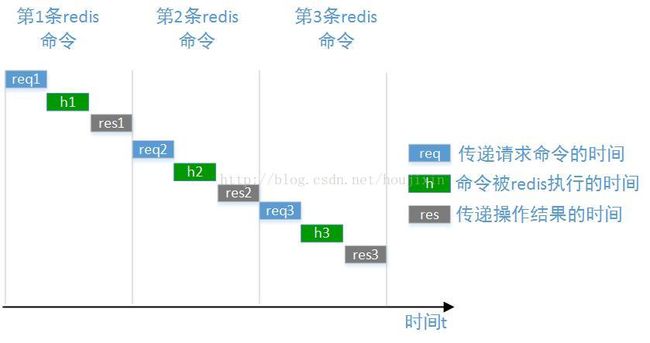关于redis的pipline和lua脚本
1. 关于redis命令执行方式的一点看法:
Redis命令执行时是串行的,在同一个连接上客户端发送一条命令,redis对这个命令进行操作然后返回结果,客户端只有接到这个结果之后才能发送下一条命令,例如:
如此串行的执行方式效率非常低,为此,redis引入了pipline,它可以让客户端依次发送一批命令过期,然后redis依次执行这些命令,并把这些命令的结果依次放入到一个list
由上面的描述可以看到,引入pipline之后,降低了多次命令-应答之间的网络交互次数,并不能缩小redis对每个命令的处理时间。
2. 那么什么时候使用pipline?什么时候使用lua呢
当多个redis命令之间没有依赖、顺序关系(例如第二条命令依赖第一条命令的结果)时,建议使用pipline;如果命令之间有依赖或顺序关系时,pipline就无法使用,此时可以考虑才用lua脚本的方式来使用;
3.注意:
(1)Redis无法提供类似数据库那种具备ACID特性的事务操作,可以基本确认引入redis就一定无法保证操作的ACID特性;因此,在咱们开发过程中,要考虑实际的应用场景,如果场景本身对ACID特性要求不那么强烈就可以考虑引入reids,否则,就只能使用数据库;
(2)能不采用lua就尽量不要采用lua
4.关于redis使用的pipline例子
private ResultStr getFullMomentFromRedis(long callIndex, String userID, String momentId)
{
String logFlag = "DataProxy.getFullMomentFromRedis";
//获取redis分片
JedisClient jedisClient = m_dataCenter.getJedisClient(callIndex, momentId);
if (jedisClient == null)
{
m_logger.error(String.format("[ci:%d]<%s>get jedis client by %s from data center fail", callIndex, logFlag, momentId));
return new ResultStr(ThriftResult.NO_CONTENT, null);
}
// 程序走的这里,说明已经从redis中获userID.mt中获取到了动态的部分信息,剩下的评论、点赞等信息继续获取
JSONObject aMomentInfo = null;
// 使用pipline一次从redis中获取剩下的点赞,评论,映射关系等信息
JedisClientPipline pipline = jedisClient.getPipline(callIndex);
// 第1个要获取的信息是动态内容
pipline.hget(userID + ".mt", momentId);
// 第2个要获取的信息是动态和frepp映射关系
pipline.get(momentId);
// 第3个要获取的信息是动态的点赞
pipline.zrevrange(momentId + ".like", 0, -1);
// 第4个要获取的信息是动态的评论
pipline.hgetAll(momentId + ".ct");
// 获取pipline返回的结果,并将所用Jedis连接返回给连接池
List下面是对redis的pipline相关操作的封装:
public class JedisClientPipline
{
private Pipeline m_pipline = null;
Jedis m_jds = null;
JedisPool m_jedisPool = null;
public JedisClientPipline(JedisPool jedisPool, Jedis jds, Pipeline p)
{
m_pipline = p;
m_jds = jds;
m_jedisPool = jedisPool;
}
public boolean get(String key)
{
if(m_pipline == null)
return false;
m_pipline.get(key);
return true;
}
public boolean hget(String key, String field)
{
if(m_pipline == null)
return false;
m_pipline.hget(key, field);
return true;
}
public boolean zrevrange(String key, long start, long end)
{
if(m_pipline == null)
return false;
m_pipline.zrevrange(key, start, end);
return true;
}
public boolean hgetAll(String key)
{
if(m_pipline == null)
return false;
m_pipline.hgetAll(key);
return true;
}
/**
* @param boolean isBad 表示当前的管道所在的jedis连接是否坏掉
* */
public List
